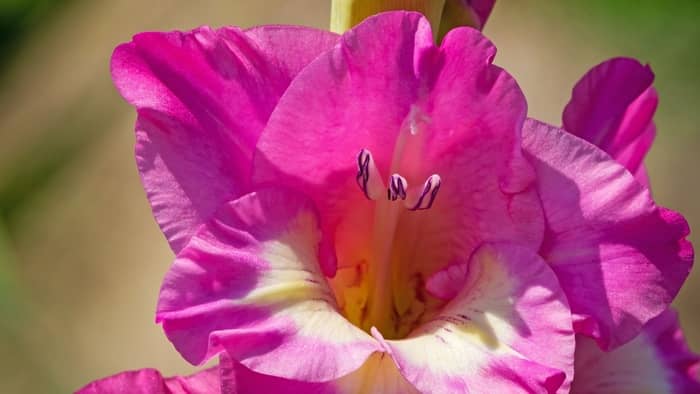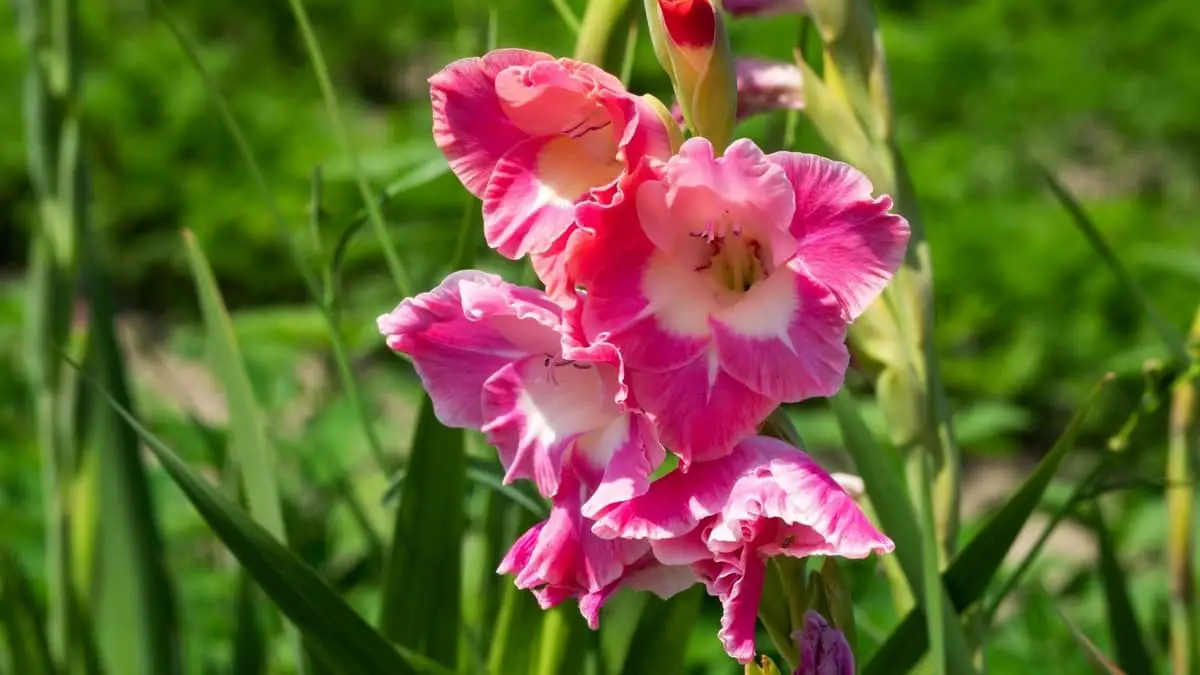Last Updated on July 26, 2022 by Griselda M.
Have you noticed your gladiolus not blooming and are wondering what the problem is and what you can do to make them flower?
Gladiolus is a large genus of flowering plants belonging to the Iridaceae family. There are about 300 species of plants in this family. These plants occur in Asia, some parts of Tropical Africa, Europe and the Mediterranean. The flowers of these plants are often used as ornamentals or fresh-cut flowers. Let’s learn the reasons why your gladiolus not blooming in this article.
All About Gladiolus
Gladiolus are grown as annuals, biennials, or perennials. They can be grown from seed or cuttings. They need rich soil, full sun, and average temperatures. If you are growing them from seed, be sure to follow the instructions for proper germination.
Gladiolus is an annual, biennial, or perennial that is native to Europe, Asia, Africa, and Australia but is now grown worldwide. They are popular in gardens for their large, showy flowers. They have a strong, erect stem with leaves along the stems. The flowers are usually on a single stem, but they can also be on a cluster of stems.
There are many different colors of gladioli including white, pink, red, orange, yellow, light purple, dark purple, and deep blue. There are also many different varieties of gladioli. They can be divided into three groups – single-flowered, double-flowered, and triple-flowered.
- Single flowered gladioli have only one flower at the top of the stem.
- Double flowered gladioli have two flowers at the top of the stem.
- Triple flowered gladioli have three or more flowers on the stem.

Why Are My Gladiolus Not Blooming?
If you are growing gladiolus and you notice they are not blooming, it’s best to learn why they are not blooming. The reasons why your gladiolus is not blooming may include:
Inefficient watering schedule.
It is very important to keep the soil moist, but not soggy. The soil should be just damp, not wet. Water is good for the roots and it helps them grow. The soil should be watered deeply once a week during the spring and summer months.
Too much or too little light.
Your plant needs a lot of sunlight. If the plant does not get enough light it will stop producing flowers. You can tell how much light your plant needs by looking at the leaves. If the leaves are yellow and curled up, it means that your plant needs more light. If the leaves are straight, it means that your plant needs less light.
Incorrect fertilizer.
Make sure you fertilize your plant with a fertilizer designed for gladiolus. Some fertilizers have chemicals that will stunt or kill your plant, so make sure that you use a fertilizer designed for gladiolus, that is balanced. The fertilizer should provide nitrogen, phosphorous and potassium needed by the plant to grow.
If your plant is not getting enough nitrogen, it will not produce flowers. Only fertilize your plant in the growing seasons, that is summer and spring. Never fertilize in winter as this may result in your plant dying and wasting fertilizer.
LED Grow Lights for Indoor Plants
How To Make Gladiolus Bloom Again?
If you lost a season when your gladiolus didn’t bloom, don’t worry, you can have your plants flowering in good time. You can do this by:
- Cutting off the old blooms, if any, so that the new growth has room to grow. The older blooms are no longer needed by the plant. Therefore it’s important to remove them so that the nutrients can go to the fresh leaves.
- Feed your gladiolus with a liquid fertilizer. Feeding your gladiolus with the liquid fertilizer is important to help it absorb it faster in order to bloom at the right time. Don’t feed it too early or the foliage will grow too much and not bloom. Rather feed it at the right time.
- Start your new gladiolus plants in a greenhouse or other protected environment. Gladiolus cannot withstand harsh weather conditions. It will therefore be good to protect them from poor environmental conditions that might stunt their growth and hinder blooming.
Take-home – Why Are My Gladiolus Not Blooming?
If you notice your gladiolus not blooming, it is essential to pause and check what you could be doing wrong. It is also possible that the flower has not developed yet or the stamens have not matured. The most likely reason for not flowering is that the plant is stressed.
The above reasons why gladiolus is not blooming should be put into consideration before giving up on your plant. So next time your plant is not flowering try a few of the above action steps and see if your plant blooms again.
Frequently Asked Questions
How do you get gladiolus to bloom?
You need to provide a greenhouse with at least 12 hours of light each day. You can also grow them outdoors, and the plants will flower as successfully in the summer months. You can put them in a pot with some compost and soil and proper drainage. Remember for potted plants you will need to water them more than the usual ones planted directly in the soil.
How long does it take gladiolus to flower?
A gladiolus plant takes approximately 10 - 12 weeks from seed to flowering. The planting time determines the harvest time so instead of planting all your gladiolus bulbs at the same time, you can space them out and plant them a week or two weeks apart.
What months do gladiolus bloom?
Gladiolus usually starts blooming around March, April and May. The flowers can be white, pink, red, purple, yellow, orange or even black. Gladiolus are also a very easy plant to grow because they are hardy and require little attention. They grow from bulbs and require a mix of peat moss and sand or perlite.
Why are my gladiolus not blooming the second year?
You may need to repot your plants, which you can do by digging up the bulbs and adding new soil. Also, check that your bulbs have not dried out and your soil is moist. If you live in an area with cold winters, you will want to keep your bulbs in a warmer location so that they don’t freeze during the winter.
Caroline is a gardener who loves to get down to the nitty–gritty of gardening. She proudly proclaims herself as a ‘dirt worshipper‘ and can often be found deep in the garden, covered in soil and singing to her plants. As a self–proclaimed ‘plant whisperer‘, Caroline believes that plants need love and attention just like any other living thing, and she loves to give them both. When she‘s not tending to her garden, you can often find her researching the latest gardening trends, or teaching others how to make their gardens thrive



